
Lissanthe is a genus of about 10 species of flowering plants in the family Ericaceae and is endemic to Australia. Plants in the genus Lissanthe are small, erect to spreading shrubs with egg-shaped to oblong leaves. Up to 17 bisexual flowers are arranged in leaf axils or on the ends of branches, the 5 petals joined at the base to form a cylindrical to urn-shaped tube with triangular lobes.

Styphelia adscendens, commonly known as golden heath, is a species of flowering plant in the heath family Ericaceae and is endemic to south-eastern Australia. It is a prostrate or low-lying shrub with lance-shaped leaves and cream-coloured, pale yellowish-green or reddish flowers arranged singly or in paris in leaf axils.

Styphelia sieberi, commonly known as prickly beard-heath, is a species of flowering plant in the heath family Ericaceae and is endemic to south-eastern continental Australia. It is an erect, densely-branched shrub with oblong to more or less egg-shaped leaves with the narrower end towards the base, and white, tube-shaped flowers arranged singly in upper leaf axils.

Leucopogon setiger is a species of flowering plant in the heath family Ericaceae and is endemic to eastern New South Wales. It is an erect to spreading shrub with lance-shaped to elliptic leaves, and white, tube-shaped flowers arranged singly or in pairs in leaf axils, forming a spike 10–16 mm (0.39–0.63 in) long.

Lissanthe strigosa, commonly known as peach heath, is a species of flowering plant in the family Ericaceae, and is endemic to south-eastern Australia. It is a shrub with linear to lance-shaped leaves and white to pink, cylindrical flowers.

Styphelia fletcheri is a species of flowering plant in the heath family Ericaceae and is endemic to south-eastern continental Australia. It is a densely-branched shrub with sharply-pointed oblong leaves, and pendent, tube-shaped white flowers in pairs in upper leaf axils.
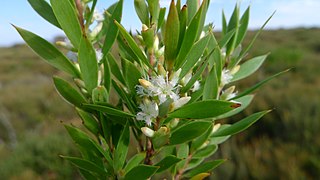
Styphelia esquamata, commonly known as the swamp beard-heath, is a species of flowering plant in the heath family Ericaceae and is endemic to south-eastern Australia. It is a slender shrub with mainly elliptic leaves, and short-lived white, tube-shaped flowers arranged singly or in pairs in upper leaf axils.

Styphelia pendula is a species of flowering plant in the heath family Ericaceae and is endemic to the south-west of Western Australia. It is an erect, straggling shrub with oblong leaves and white, tube-shaped flowers that are bearded inside.
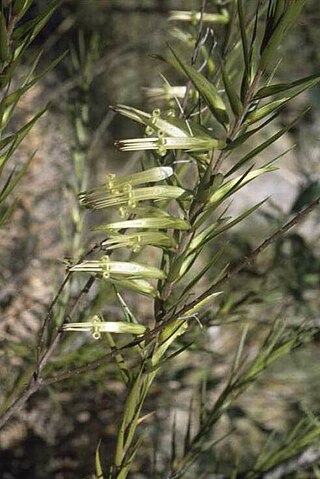
Styphelia longifolia, commonly known as long-leaf styphelia, is a species of flowering plant in the heath family Ericaceae and is endemic to New South Wales. It is an erect shrub with more or less lance-shaped leaves and pale green or yellow flowers arranged singly in leaf axils.

Styphelia mutica, commonly known as blunt beard-heath, is a species of flowering plant in the heath family Ericaceae and is endemic to eastern Australia. It is an erect, straggling shrub with egg-shaped leaves with the narrower end towards the base, and small numbers of white, tube-shaped flowers that are densely bearded inside.

Styphelia appressa is a species of flowering plant in the heath family Ericaceae and is endemic to south-eastern New South Wales. It is a small, spreading to erect shrub with wiry stems, lance-shaped or narrowly egg-shaped to elliptic leaves and small white flowers.

Styphelia biflora is a species of flowering plant in the heath family Ericaceae and is endemic to eastern Australia. It is an erect to spreading shrub with hairy branchlets, oblong leaves and small white flowers.

Leucopogon collinus, commonly known as fringed beard-heath, is a species of flowering plant in the heath family Ericaceae and is endemic to south-eastern Australia. It is a slender, erect or spreading shrub with narrowly lance-shaped leaves, and white, tube-shaped, bearded flowers.
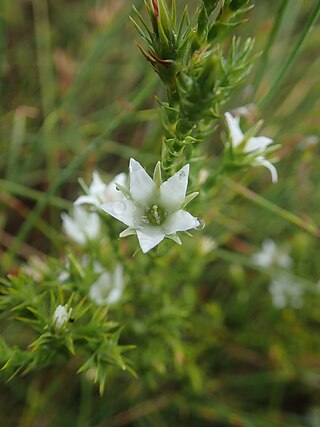
Sprengelia sprengelioides is a species of flowering plant of the family Ericaceae, and is endemic to near-coastal areas of eastern Australia. It is an erect shrub with egg-shaped leaves, and white flowers arranged singly in leaf axils.

Styphelia deformis is a species of flowering plant in the heath family Ericaceae and is endemic to eastern coastal Australia. It is a bushy shrub with narrowly egg-shaped leaves, and white, tube-shaped flowers.
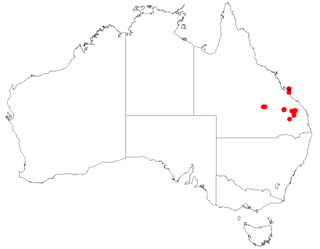
Styphelia flexifolia is a species of flowering plant in the family Ericaceae and is endemic to south-east Queensland. It is a rigid shrub with many softly-hairy branchlets, crowded, sharply-pointed linear to lance-shaped leaves, and small, white, bell-shaped flowers that are bearded inside.

Pimelea latifolia is a species of flowering plant in the family Thymelaeaceae and is endemic to eastern Australia. It is a shrub with hairy young stems, egg-shaped leaves with the narrower end towards the base, and greenish-yellow to white, tube-shaped flowers.
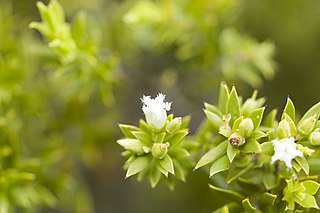
Styphelia leptospermoides is a species of flowering plant in the heath family Ericaceae and is endemic to eastern Australia. It is an erect, bushy shrub with elliptic to lance-shaped or oblong leaves, and white, tube-shaped flowers usually arranged singly in upper leaf axils.

Styphelia margarodes is a species of flowering plant in the heath family Ericaceae and is endemic to near-coastal areas of eastern Australia. It is an erect, spreading shrub with egg-shaped leaves with the narrower end towards the base, and small numbers of white, tube-shaped flowers usually arranged singly or in pairs in upper leaf axils.

Leucopogon virgatus, commonly known as common beard-heath, is a species of flowering plant in the heath family Ericaceae and is endemic to south-eastern Australia. It is an erect to low-lying shrub with linear to narrowly lance-shaped or egg-shaped leaves, and erect clusters of three to seven white, tube-shaped flowers on the ends of branches and in upper leaf axils.



















